HONDA CIVIC 1991 Owners Manual
Manufacturer: HONDA, Model Year: 1991, Model line: CIVIC, Model: HONDA CIVIC 1991Pages: 136, PDF Size: 1.33 MB
Page 121 of 136
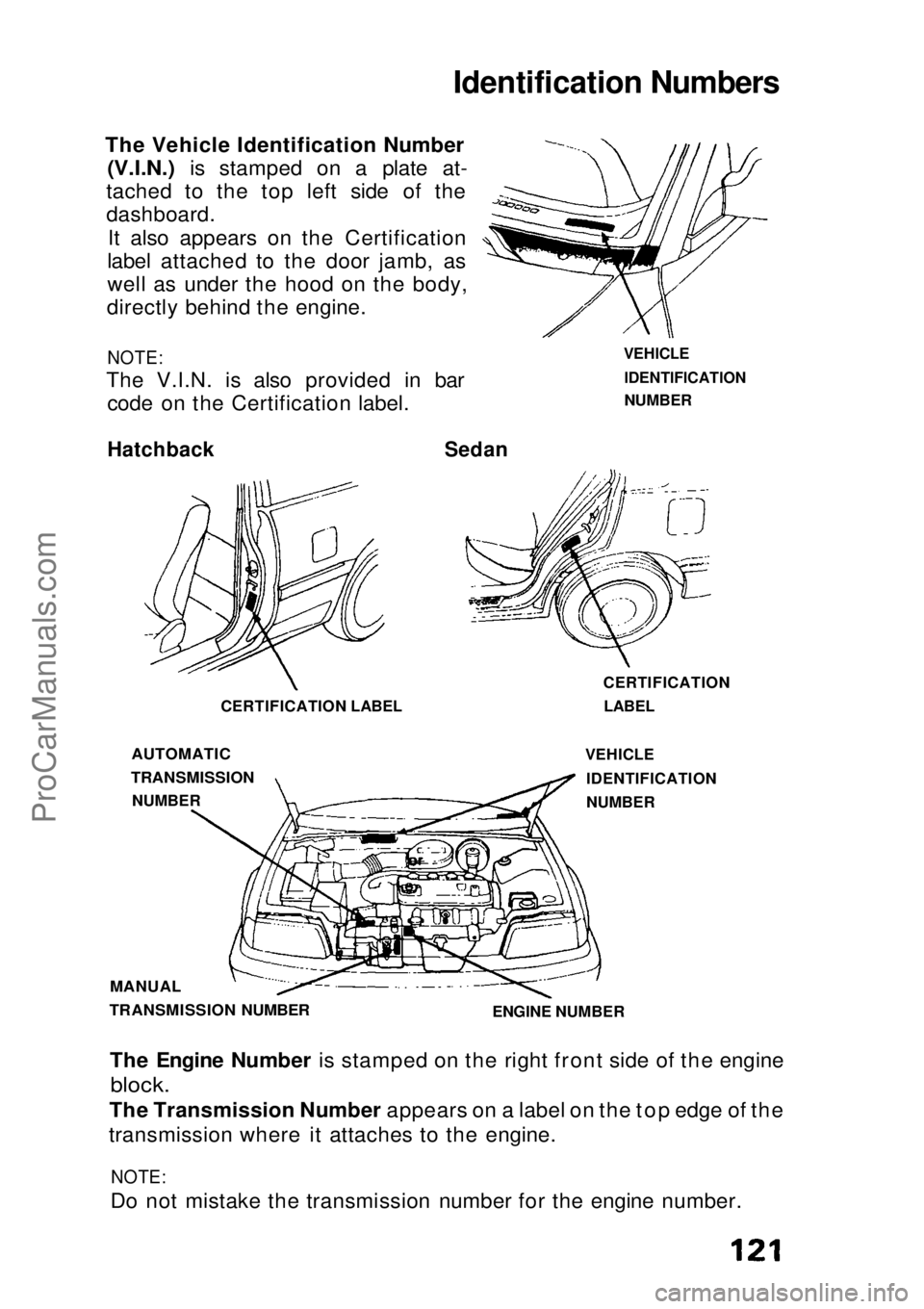
Identification Numbers
The Vehicle Identification Number(V.I.N.) is stamped on a plate at-
tached to
the top left side of the
dashboard.
It also appears on the Certification
label attached to the door jamb, as
well as under the hood on the body,
directly behind the engine.
NOTE:
The V.I.N. is also provided in bar code on the Certification label.
Hatchback Sedan
CERTIFICATION LABEL
AUTOMATIC
TRANSMISSION
NUMBER
CERTIFICATION
LABEL
MANUAL
TRANSMISSION NUMBER
ENGINE NUMBER
The Engine Number is stamped on the right front side of the engine
block.
The Transmission Number appears on a label on the top edge of the
transmission where it attaches to the engine.
NOTE:
Do not mistake the transmission number for the engine number.
VEHICLE
IDENTIFICATION
NUMBER
VEHICLE IDENTIFICATION
NUMBERProCarManuals.comMain Menu s t
Page 122 of 136
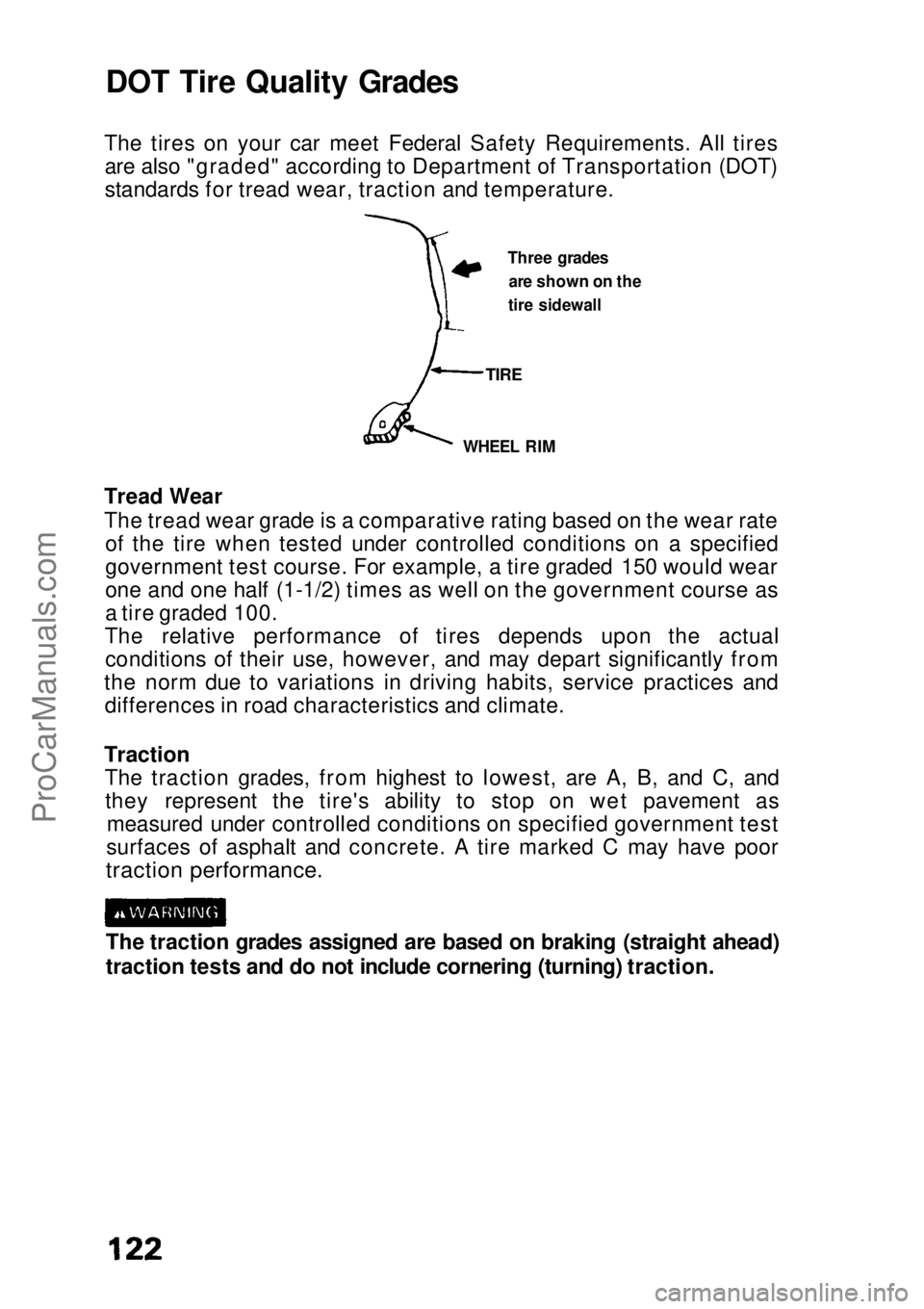
DOT Tire Quality Grades
The tires on your car meet Federal Safety Requirements. All tires are also "graded" according to Department of Transportation (DOT)
standards for tread wear, traction and temperature.
Tread Wear
The tread wear grade is a comparative rating based on the wear rate of the tire when tested under controlled conditions on a specified
government test course. For example, a tire graded 150 would wear
one and one half (1-1/2) times as well on the government course as
a tire graded 100.
The relative performance of tires depends upon the actual conditions of their use, however, and may depart significantly from
the norm due to variations in driving habits, service practices and differences in road characteristics and climate.
Traction
The traction grades, from highest to lowest, are A, B, and C, andthey represent the tire's ability to stop on wet pavement as measured under controlled conditions on specified government test
surfaces of asphalt and concrete. A tire marked C may have poor
traction performance.
The traction grades assigned are based on braking (straight ahead)
traction tests and do not include cornering (turning) traction. Three grades
are shown on the
tire sidewall
TIRE
WHEEL RIMProCarManuals.comMain Menu s t
Page 123 of 136

Temperature
The temperature grades are A (the highest), B and C representing
the tire's resistance to the generation of heat and its ability to
dissipate heat when tested under controlled conditions on a
specified indoor laboratory test wheel. Sustained high temperaturecan cause the material of the tire to degenerate and reduce tire life,
and excessive temperature can lead to sudden tire failure. The grade C corresponds to a level of performance which all passenger car
tires must meet under the Federal Motor Vehicle Safety Standard No. 109. Grades B and A represent higher levels of performance on
the laboratory test wheel than the minimum required by law.
The tire temperature grade is established for a tire that is properly inflated and not overloaded. Excessive speed, underinflation, or
excessive loading, either separately or in combination, can cause
heat buildup and possible tire failure.ProCarManuals.comMain Menu s t
Page 124 of 136

Emission Controls
Sources of Emissions
The combustion process produces carbon monoxide, oxides of nitrogen and hydrocarbons. The evaporation of fuel in the fuel tank
also produces hydrocarbons. Control of oxides of nitrogen andhydrocarbons is very important since, under certain conditions,
when subjected to sunlight, they react to form photochemical smog. Carbon monoxide does not react to form smog, but it is toxic.Honda Motor Co., Ltd. has developed a number of systems which
are highly effective in reducing carbon monoxide, oxides of nitrogen
and hydrocarbons.
The Clean Air Act The Clean Air Act requires all vehicle manufacturers to explain in
writing, the operation and maintenance of their emission control
systems.
Maintenance instructions are included on pages 68 — 73 ; the
operation of each system is explained on the following.
Replacement Parts
The emission control systems on your new Honda were designed, built and certified to conform with the Federal regulations
implementing the Clean Air Act. Honda recommends only the use of
new, genuine Honda parts or their equivalent. The use of otherreplacement parts which are not of equivalent quality may impair
the effectiveness of your car's emission control systems.
Crankcase Emission Control System
To prevent crankcase emissions, your car is equipped with a Positive Crankcase Ventilation (PCV) System which routes blowby
gases from the crankcase, through the PCV valve and intakemanifold, into the combustion chamber.ProCarManuals.comMain Menu s t
Page 125 of 136

Evaporative Emission Control System
The Evaporative Emission Control System is designed to prevent
fuel vapors from escaping into the atmosphere. Fuel vapors from the fuel tank are directed into the charcoal
canister where they are adsorbed and stored while the engine is stopped or idling. When the coolant temperature rises to a certain
value, the vapors are drawn into the engine through the throttlebody and the intake manifold during normal engine operation.
Engine Exhaust Emission Controls
The engine exhaust emission control systems are designed to control combustion during idle, acceleration, cruise, and deceleration.
These systems are entirely separate from the crankcase and evaporative emission control systems described previously.
HONDA PGM-FI System
The PGM-FI system consists of three independent sub-systems; Air Intake, Electronic Control and Fuel Control, thus allowing moreaccurate control of air/fuel ratios under all operating conditions.
The Electronic Control Unit (ECU) detects the amount of air
drawn into the cylinders and determines the amount of fuel to be injected to provide the optimum air/fuel ratio for all engine needs.
Ignition Timing Control System
This system automatically controls the ignition timing to reduce
the amount of HC and NOx.
Catalytic Converter
Three Way Catalyst
The catalyst is used to convert hydrocarbons (HC), carbon monoxide (CO) and oxides of nitrogen (NOx) in the exhaust gas,
to carbon dioxide (CO 2
), dinitrogen (N 2
) and water vapor.
Exhaust Gas Recirculation (EGR) (California automatic models except EX Sedan)
The EGR system is designed to control the formation of oxides of nitrogen (NOx) caused when fuel mixture burns at high
temperature. It works by recirculating exhaust gas through the EGR valve and intake manifold into the combustion chambers
where it reduces peak temperature by diluting the air/fuel mixture.ProCarManuals.comMain Menu s t
Page 126 of 136
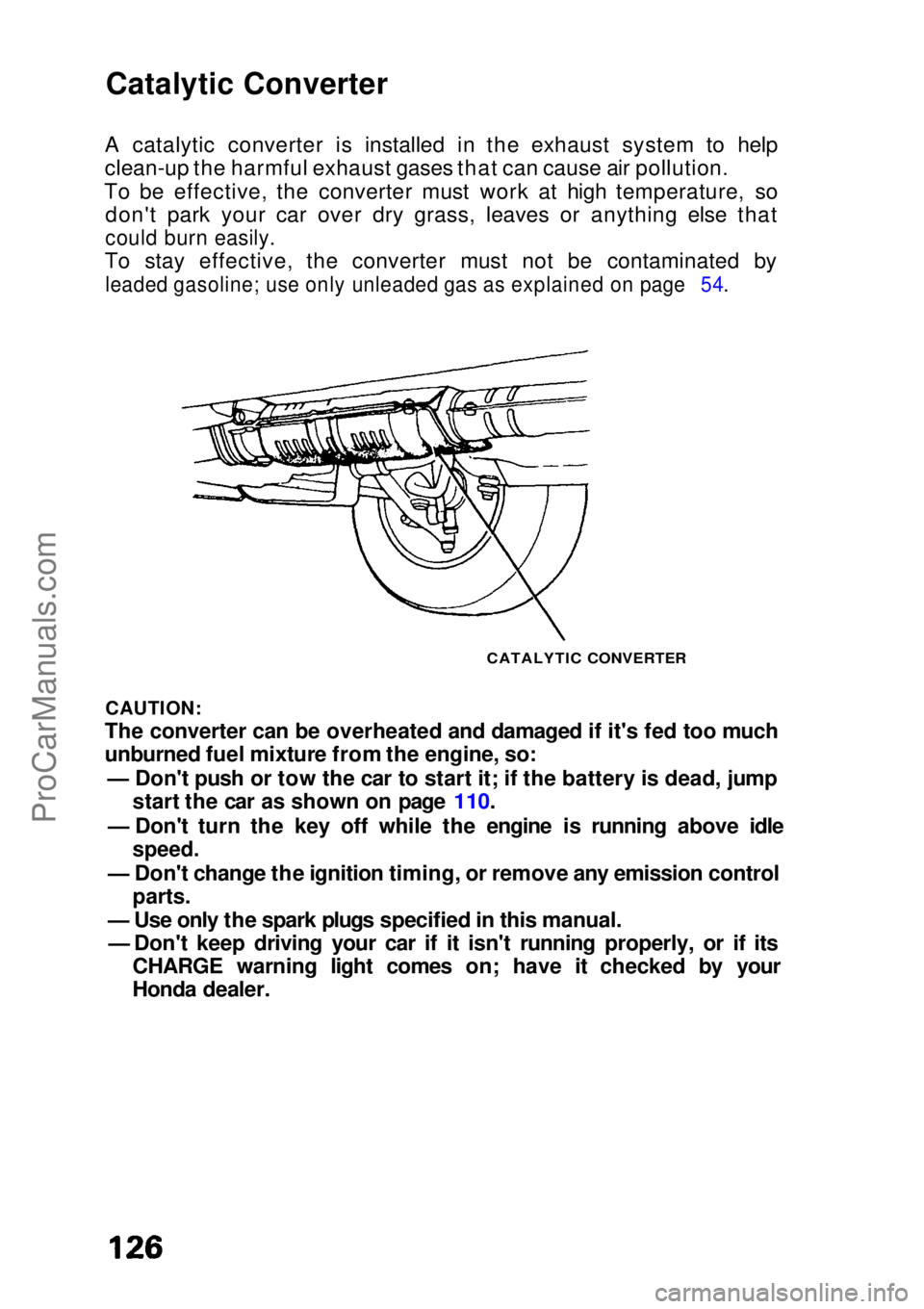
Catalytic Converter
A catalytic converter is installed in the exhaust system to help
clean-up the harmful exhaust gases that can cause air pollution.
To be effective, the converter must work at high temperature, so don't park your car over dry grass, leaves or anything else that
could burn easily.
To stay effective, the converter must not be contaminated by
leaded gasoline; use only unleaded gas as explained on page 54.
CAUTION:
The converter can be overheated and damaged if it's fed too much
unburned fuel mixture from the engine, so:
— Don't push or tow the car to start it; if the battery is dead, jump start the car as shown on page 110.
— Don't turn the key off while the engine is running above idle
speed.
— Don't change the ignition timing, or remove any emission control
parts.
— Use only the spark plugs specified in this manual. — Don't keep driving your car if it isn't running properly, or if its CHARGE warning light comes on; have it checked by your
Honda dealer.
CATALYTIC CONVERTERProCarManuals.comMain Menu s t
Page 127 of 136

Warranty Service
Warranty
The following warranties are provided with every new vehicle. 1. New Car Limited Warranty
2. Emission Control Systems Defects Warranty
3. Emission Performance Warranty
4. Original Equipment Battery Limited Warranty 5. Rust Perforation Limited Warranty
6. Accessory Limited Warranty 7. Replacement Parts Limited Warranty
8. Replacement Muffler Lifetime Limited Warranty 9. Seat Belt Limited Warranty
10.Replacement Battery Limited Warranty
Your car's original tires are covered by their manufacturer. Tirewarranty information is in a separate booklet.
All warranty details pertaining to your car can be found in theWarranty booklet provided with your new car except the requiredmaintenance schedule which is contained here in the Owner's
Manual.
If you are unable to obtain warranty service or are dissatisfied with
the warranty decision or service you received at an authorized Honda dealership, you should review the matter with that
dealership's Service Manager. This will normally resolve your problem. If it does not resolve your problem you should appeal the
decision with the owner of the dealership. Please bear in mind that
your problem will likely be resolved at the dealership, using the
dealer's facilities, equipment and personnel. So it is very important
that your initial contact be with the dealer or his management.
After following these steps, if you wish to have the matter
reviewed by American Honda you should contact the Zone Office
serving your area, as shown on the map on the inside of the back
cover. When contacting American Honda, please provide the Zone
Office with the following information:
Vehicle Identification Number
Servicing Dealer Name and Address
Date of Purchase
Mileage on your Car
Your Name, Address, and Phone Number Nature of Problem
Selling Dealer
After a review of the facts, you will be advised of what can be done.ProCarManuals.comMain Menu s t
Page 128 of 136

Reporting Safety Defects
If you believe that your vehicle has a defect which could cause a
crash or could cause injury or death, you should immediately inform
the National Highway Traffic Safety Administration (NHTSA) in addition to notifying American Honda Motor Co., Inc.If NHTSA receives similar complaints, it may open an investigation,
and if it finds that a safety defect exists in a group of vehicles, it
may order a recall and remedy campaign.
However, NHTSA cannot become involved in individual problems
between you, your dealer, or American Honda Motor Co., Inc.
To contact NHTSA, you may either call the Auto Safety Hotline toll-
free at 1-800-424-9393 (or 366-0123 in Washington, D.C. area) or
write to:
NHTSA, U.S. Department of Transportation
Washington, D.C. 20590. You can also obtain other information about motor vehicle safety
from the Hotline.ProCarManuals.comMain Menu s t
Page 129 of 136
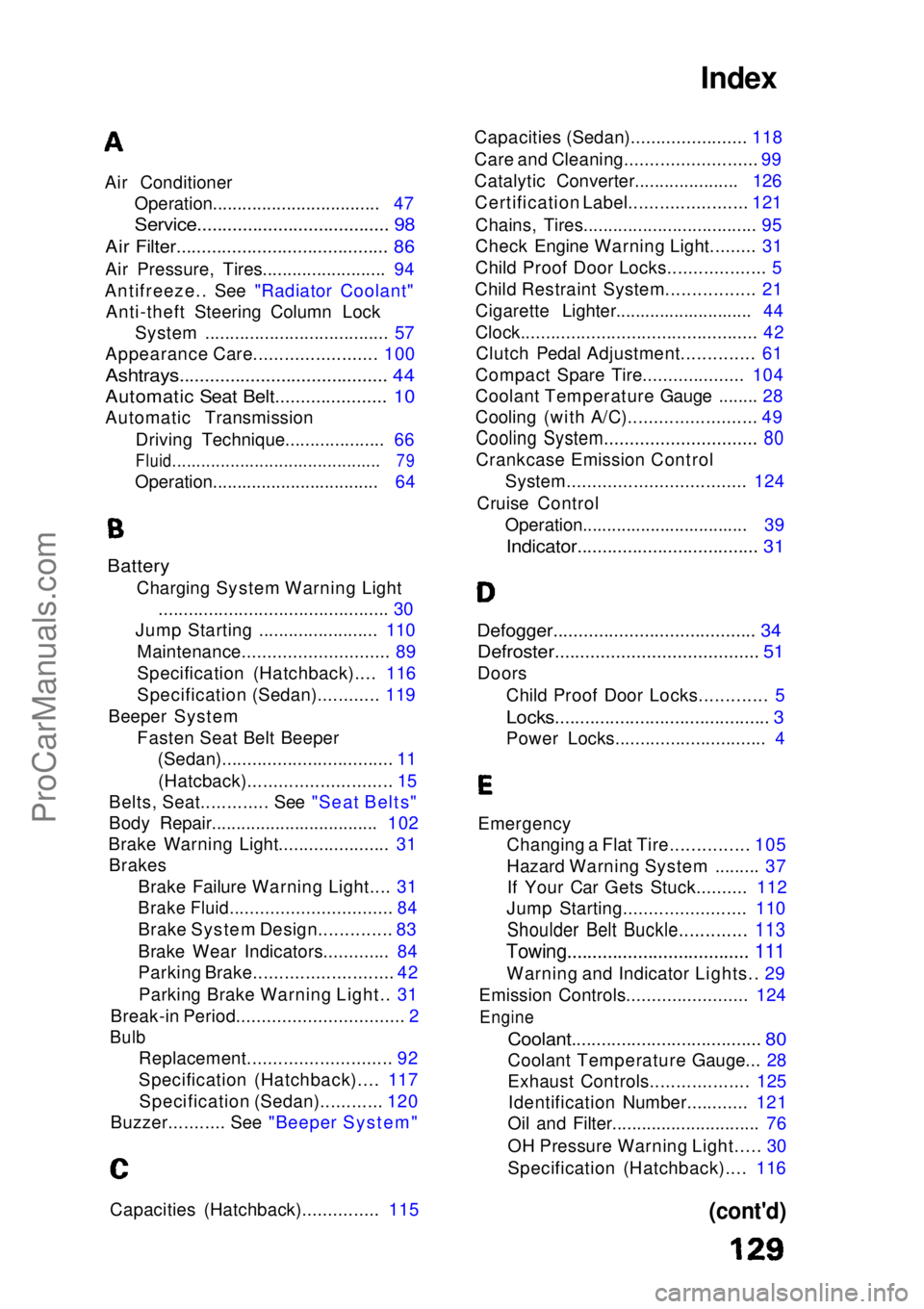
Index
Battery
Charging System Warning Light.............................................. 30
Jump Starting ........................ 110
Maintenance............................. 89
Specification (Hatchback).... 116
Specification (Sedan)............ 119
Beeper System Fasten Seat Belt Beeper(Sedan).................................. 11
(Hatcback)............................ 15
Belts, Seat............. See "Seat Belts"
Body Repair.................................. 102
Brake Warning Light...................... 31 Brakes
Brake Failure Warning Light.... 31
Brake Fluid................................ 84
Brake System Design.............. 83
Brake Wear Indicators............. 84
Parking Brake........................... 42
Parking Brake Warning Light.. 31
Break-in Period................................. 2
Bulb
Replacement............................
92
Specification (Hatchback)....
117
Specification (Sedan)............
120
Buzzer........... See
"Beeper System"
Capacities (Hatchback)............... 115 Capacities (Sedan)....................... 118
Care and Cleaning.......................... 99
Catalytic Converter..................... 126 Certification Label....................... 121
Chains, Tires...................................
95
Check Engine
Warning Light......... 31
Child Proof Door Locks...................
5
Child Restraint
System................. 21
Cigarette Lighter............................ 44
Clock............................................... 42
Clutch Pedal Adjustment.............. 61
Compact Spare Tire.................... 104
Coolant Temperature Gauge ........
28
Cooling (with
A/C).........................
49
Cooling System..............................
80
Crankcase Emission Control
System................................... 124
Cruise Control Operation.................................. 39
Indicator.................................... 31
Defogger........................................ 34
Defroster........................................ 51
Doors
Child Proof Door Locks............. 5
Locks........................................... 3
Power Locks.............................. 4
Emergency
Changing a Flat Tire............... 105
Hazard Warning System ......... 37If Your Car Gets Stuck.......... 112
Jump Starting........................ 110
Shoulder Belt Buckle............. 113
Towing.................................... 111
Warning and Indicator Lights.. 29
Emission Controls........................ 124
Engine
Coolant...................................... 80
Coolant Temperature Gauge... 28
Exhaust Controls................... 125Identification Number............ 12
1
Oil and
Filter.............................. 76
OH Pressure Warning Light..... 30
Specification (Hatchback).... 116
Air Conditioner
Operation.................................. 47
Service...................................... 98
Air Filter.......................................... 86
Air Pressure, Tires......................... 94
Antifreeze.. See "Radiator Coolant" Anti-theft Steering Column Lock System ..................................... 57
Appearance Care........................ 100
Ashtrays......................................... 44
Automatic Seat Belt...................... 10
Automatic Transmission
Driving Technique.................... 66
Fluid........................................... 79
Operation.................................. 64
(cont'd)ProCarManuals.comMain Menu s t
Page 130 of 136
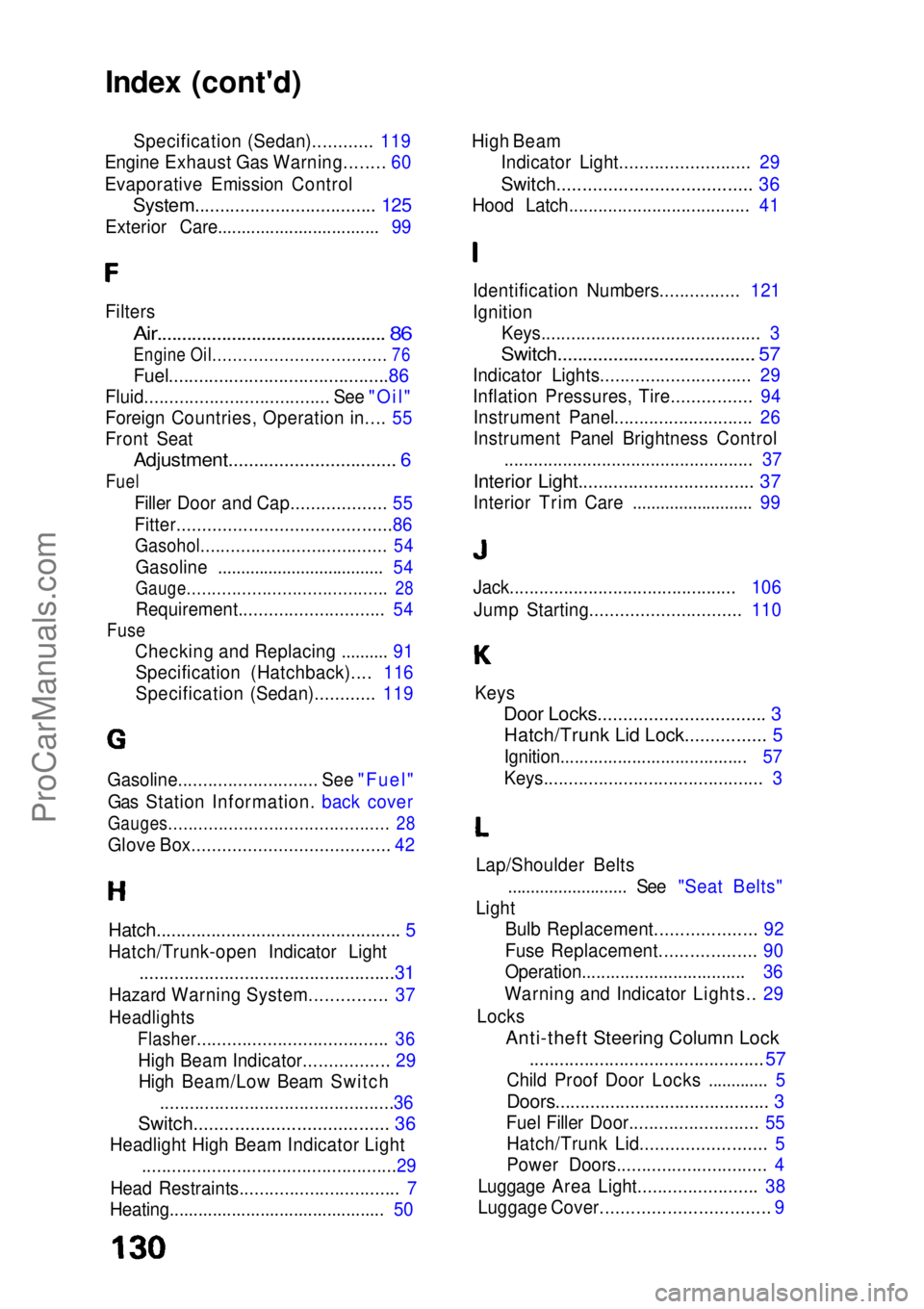
Index (cont'd)
Specification (Sedan)............ 119
Engine Exhaust Gas Warning........ 60
Evaporative Emission Control
System.................................... 125
Exterior Care.................................. 99
Filters
Air.............................................. 86
Engine Oil.................................. 76
Fuel........................................... .86
Fluid..................................... See "Oil"
Foreign Countries, Operation in.... 55
Front Seat
Adjustment................................. 6
Fuel
Filler Door and Cap................... 55
Fitter..........................................86
Gasohol..................................... 54
Gasoline .................................... 54
Gauge........................................ 28
Requirement............................. 54
Fuse
Checking and Replacing .......... 91Specification (Hatchback).... 116
Specification (Sedan)............ 119
Hatch................................................. 5
Hatch/Trunk-open Indicator Light
...................................................31
Hazard Warning System............... 37
Headlights
Flasher...................................... 36
High Beam Indicator................. 29High Beam/Low Beam Switch ...............................................36
Switch...................................... 36
Headlight High Beam Indicator Light
...................................................29
Head Restraints................................ 7
Heating............................................. 50 High Beam
Indicator Light.......................... 29
Switch...................................... 36
Hood Latch..................................... 41
Identification Numbers................ 121
Ignition Keys............................................ 3
Switch....................................... 57
Indicator Lights.............................. 29
Inflation Pressures, Tire................ 94 Instrument Panel............................ 26
Instrument Panel Brightness Control ................................................... 37
Interior Light................................... 37
Interior Trim Care .......................... 99
Keys
Door Locks................................. 3
Hatch/Trunk Lid Lock................ 5
Ignition....................................... 57
Keys............................................ 3
Lap/Shoulder Belts .......................... See "Seat Belts"
Light Bulb Replacement.................... 92
Fuse Replacement................... 90
Operation.................................. 36
Warning and Indicator Lights.. 29
Locks
Anti-theft Steering Column Lock...............................................57
Child Proo f
Door Locks ............. 5
Doors........................................... 3
Fuel Filler Door.......................... 55 Hatch/Trunk Lid......................... 5
Power Doors.............................. 4
Luggage Area Light........................ 38
Luggage Cover................................. 9
Gasoline............................ See "Fuel"
Gas Station Information. back cover
Gauges............................................ 28
Glove Box....................................... 42 Jack.............................................. 106
Jump Starting.............................. 110ProCarManuals.comMain Menu s t